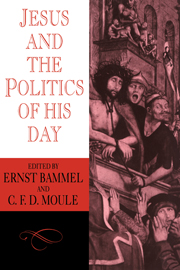Book contents
- Frontmatter
- Contents
- Abbreviations
- Foreword
- The Zealots and Jesus
- The revolution theory from Reimarus to Brandon
- The date and character of Mark
- Some observations on Tendenzkritik
- Argumentum e silentio
- The Poor and the Zealots
- The opposition between Jesus and Judaism
- Judaeo-Christianity and the Jewish establishment, A.D. 33–66
- A.D. 70 in Christian reflection
- The trial of Jesus in the Acta Pilati
- Christ as brigand in ancient anti-Christian polemic
- Jesus as a political agent in a version of the Josippon
- The Feeding of the Multitude
- The coin of ‘Render unto Caesar …’ (A note on some aspects of Mark 12: 13–17; Matt. 22: 15–22; Luke 20:20–26)
- Render to Caesar
- The Temple tax
- ‘Not peace but a sword’: Matt. 10:34ff; Luke 12: 51ff
- The decision of the Supreme Court to put Jesus to death (John 11:47–57) in its context: tradition and redaction in the Gospel of John
- The ‘triumphal’ entry
- The two swords (Luke 22: 35–38)
- The titulus
- Romans 13
- Biblical criticism criticised: with reference to the Markan report of Jesus's examination before the Sanhedrin
- The political charge against Jesus (Luke 23: 2)
- The trial before Pilate
- ‘His witness is true’: A test of the Johannine claim
- Index of Authors
- Index of References
The ‘triumphal’ entry
Published online by Cambridge University Press: 19 January 2010
- Frontmatter
- Contents
- Abbreviations
- Foreword
- The Zealots and Jesus
- The revolution theory from Reimarus to Brandon
- The date and character of Mark
- Some observations on Tendenzkritik
- Argumentum e silentio
- The Poor and the Zealots
- The opposition between Jesus and Judaism
- Judaeo-Christianity and the Jewish establishment, A.D. 33–66
- A.D. 70 in Christian reflection
- The trial of Jesus in the Acta Pilati
- Christ as brigand in ancient anti-Christian polemic
- Jesus as a political agent in a version of the Josippon
- The Feeding of the Multitude
- The coin of ‘Render unto Caesar …’ (A note on some aspects of Mark 12: 13–17; Matt. 22: 15–22; Luke 20:20–26)
- Render to Caesar
- The Temple tax
- ‘Not peace but a sword’: Matt. 10:34ff; Luke 12: 51ff
- The decision of the Supreme Court to put Jesus to death (John 11:47–57) in its context: tradition and redaction in the Gospel of John
- The ‘triumphal’ entry
- The two swords (Luke 22: 35–38)
- The titulus
- Romans 13
- Biblical criticism criticised: with reference to the Markan report of Jesus's examination before the Sanhedrin
- The political charge against Jesus (Luke 23: 2)
- The trial before Pilate
- ‘His witness is true’: A test of the Johannine claim
- Index of Authors
- Index of References
Summary
The tradition of the ‘triumphal’ entry plays a crucial role in the Markan scheme. The confession of Jesus as messiah in 8:27–30 had followed a miracle on a blind man (8: 22–6) and had led immediately into a complex of material (8:31 to 10:45) structured by three sayings about the suffering Son of man (8: 31–3; 9: 30–2; 10: 32–4) and several ensuing traditions about discipleship. With 10:46–52 the journey to Jerusalem has reached Jericho where there occurs a further miracle on a blind man. This tradition is clamped to the following tradition of the entry quite unmistakably: in both ‘the way’ is mentioned (10:46, 52; 11:8), in both Jesus is acclaimed in Davidic terms (10: 47f; 11: 10), in both there is a ἱμάτιoν reference (10: 50; 11:71), in both the theme of salvation is prominent (10:52; 11:9), and significantly in both acclamation and following are joined (10: 52; 11:9). Consequently it appears that the Markan plan is to link 11: 1–10 with 10:46–52 in much the same way as 8: 27–30 is linked with 8: 22–6. The ‘triumphal’ entry, therefore, matches the confession and has to do with the disclosure of Jesus's identity and status.
This Markan presentation of the entry into Jerusalem by the one who has already effected a victory is precisely what permits a classification of the story as such. For there is already in existence a family of stories detailing the celebratory entry to a city by a hero figure who has previously achieved his triumph.
- Type
- Chapter
- Information
- Jesus and the Politics of his Day , pp. 319 - 334Publisher: Cambridge University PressPrint publication year: 1984
- 6
- Cited by

